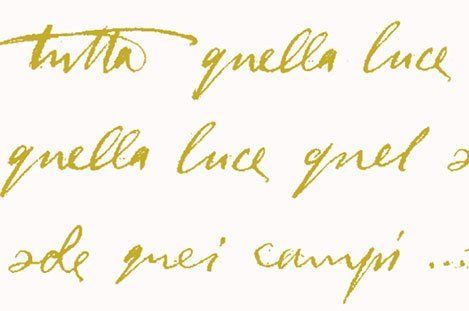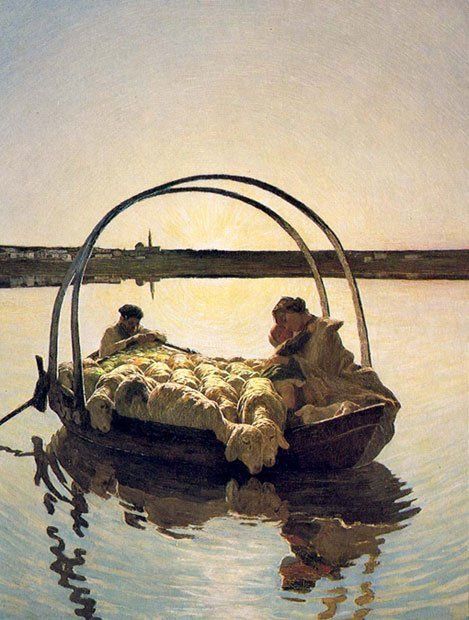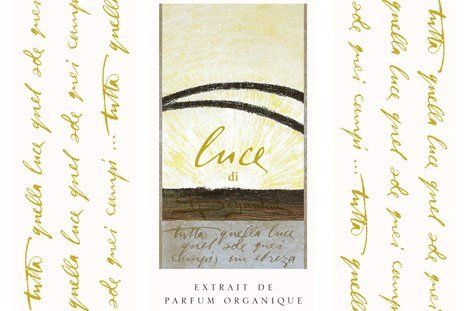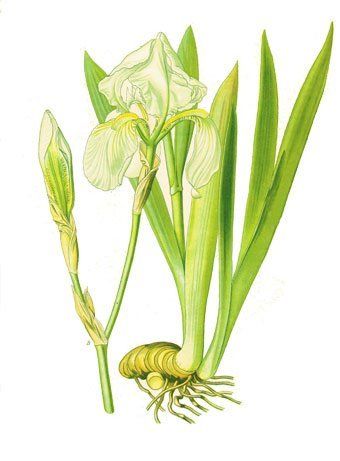LUCE DI SEGANTINI

LUCE DI SEGANTINI
Extrait de Parfum organiqueThe perfume, smells of violets, hedgerow roses and the coniferous forests of the the beautiful Engadine area of the Alps, - an area where the light is radiant. Purest essences were used to develop LUCE DI SEGANTINI, and the ingredients are the highest quality and obtained world wide. The composition of this perfume is made up of pure ingredients of the highest calibre and LUCE DI SEGANTINI envelopes us like the finest silk.
There are some very happy circumstances surrounding the development of this perfume. Please read the story written by Mrs. Gioconda Seganitini in "From the Idea to the Perfume." :
https://www.segantini-parfum.com/index.php/en/
(Downloaded for you from the German Newspaper FAZ)
FAZ Artikel zum Parfum (3,2 MB; DIN A3)
AVE MARIA Painting by GIOVANNI SEGANTINI
This perfume is the olfactory transformation of the painting AVE MARIA. The artist, along with his granddaughter Gioconda, collaborated for a period of 17 months to inspire the perfume. The start of the perfume development was in March 2015.
At this point I can not describe in a few words the implementation of the painting AVE MARIA in the perfume LUCE DI SEGANTINI. A lecture is possible if you wish to know more about the connection between the painting Ave Maria the perfume LUCE DI SENGANTINI. Please contact me at: post (at) art-parfum.eu
If you would like to know more about the painter GIOVANNI SEGANTINI, visit the website: www.segantini.com
We recommend a visit to the SEGANTINI MUSEUM, St. Moritz to appreciate in full the painting AVE MARIA
from which LUCE DI SEGANTINI was developed: SEGANTINI MUSEUM St. Moritz.

Find out more ...
TESTER and the PARFUM can be obtained directly at the following website: https://www.segantini-parfum.com/index.php/de/das-parfum* Test the perfume on the skin; This very complex composition develops differently on every type of skin. Watch the progress ... ...
* On the shelf life of the perfume: in cool, dark storage well above the legal standard of 2 years. For example, you can store a bottle of genuine sandalwood (Santalum album) like a bottle of wine, the fragrance becomes more and more beautiful over the years. 'LUCE DI SEGANTINI could also be stored' should read "It could be stored like a work of art and the precious perfume bottle GIVEN to children and grandchildren..
Hotel Suvretta - St. Moritz
A first presentation of the perfume LUCE DI SEGANTNI took place at the Hotel Suvretta / St. Moritz on 5 August 2016. The perfume can also be purchased directly at the Hotel Suvretta: www.suvrettahouse.ch


World's best harvests
I only processed the best harvests from all over the world in LUCE DI SEGANTINI. Here are some examples with detailed descriptions for you:IRIS
Iris pallida
Family: Iridaceae
Origin: Italien
Heart fragrance: Mostly water vapor distillation from the roots, which were previously stored for three years (fragrance formation by fermentation)
Special feature:
The Romans and the Greeks valued Iris as a fragrance. Iris is used as a fixative in noble perfumes. Iris, named after the goddess of the rainbow, is one of the most precious fragrances in the world. Deeply hidden in Mother Earth, this light-bearing essence is extracted from the roots of Iris pallida, a species of sword lily. A violet-like scent with a soft, flowery undertone, powdery, radiant.
The Romans and the Greeks valued Iris as a fragrance.
On the Schafberg / Pontresina in Switzerland
For the development of the fragrance LUCE DI SEGANTINI, it was important for me to go to the Schafberg north of Pontresina in Engadin / Switzerland. The Segantini hut is situated at 2731 meters above sea level, where the painter often lingered and painted on his easel. A little off the hut, on July 12, 2015, I picked a few yarrow blossoms and set them as a mother tincture. This mother tincture creates the essence of Schafberg and it flows in to the perfume flask of LUCE Di SEGANTINI.
Other ingredients of LUCE DI SEGANTINI
VIOLET
Viola odorata
Family: Violaceae
Heart fragrance: Hexane extraction of green leaves
Origin: Ägypten
Special feature:
Violets and iris are a source of confusion when it comes to "typical violet". The typical violet perfume is replaced today in perfumes and cosmetics by synthetic Jonone; As is the case with the known violet pastilles. Even for the romantic violet perfumes of the 19th century - when there were no synthetic odors - the precious "Iris essence" was used as a violet-like fragrance. Obtaining an iris essence is, however, very costly. The result, however, is worth every effort, so radiantly beautiful and truly fragrant after delicate violets.
However, in LDS, the perfume of the true violet also flows from the heart shaped leaves of the Viola Odonata with its heavy, earthy-grass-green smells. The magic of the transformation comes only when this intensive fragrance is diluted, and the mood-brightening fine light effect, is allowed to unfold.
JASMIN
Jasminum grandiflorum
Family: Oleaceae
Heart fragrance: Solvent extraction with hexane, or further with ethyl alcohol
Origin: Egypt
Special feature:
Jasmine is called "moonlight in the grove" in India. The moonlight-colored flowers smell, especially in the night, so charming, so lavish. From 2 o'clock in the morning the tender jasmine flowers are carefully selected by experienced dexterous women pickers, who harvest the blossoms. For one kg of jasmine scent one needs the unimaginable quantity of 8 million flowers. This precious natural jasmine costs over 30,000 euros, while the synthetic jasmine is traded with a few euros. The complexity, the beauty and the sensual beguiling essence of the real jasmine can never be achieved from a synthetic source. From the collected jasmine blossoms one obtains a sensation which makes us optimistic, and gives us an indescribable feminine feel from the lush jasmine scent.
ARVE / CRYSTALLIZERS
Pinus cembra
Family: Pinaceae
Head cardiac perfume: Water vapor distillation of the crushed branches and branches with needles
Origin: Austria, Switzerland
Special feature:
The Arve is considered the queen of the Alps and grows most slowly among all conifers. The Styrian research company "Joanneum Research" has proven that sleeping in a bed of arven wood reduces the heart rate and results in a savings of 3,500 heart attacks per day.
Knotted, solitary arvens in the middle of the battle zone on the edge of the forest are the epitome of weather trees. It grows in the high Alps up to the tree line of 2700 meters. As a pioneer plant, it colonizes and consolidates rockfalls. The pine is also a light-hungry tree, it loves the free heights. In the valley, in a closed dark forest, she would not survive. Arven can become ancient. Thus they found their way into the fairy tales and legends of our ancestors, are a symbol of longevity, endurance, strength and protection. The essential oils smell powerful, fresh and pure, capturing the special alpine landscape in its fragrance.
YARROW
Achillea millefolium
Family: Asteraceae
Heart fragrance: Water vapor distillation of dried flowering flowers and cabbage
Country of origin: Hungary
Special feature:
The color of yarrow oil is blue because of the high content of chamazulen. The botanical name Achillea derives from the Greek hero Achilles, who according to the legend was supposed to have treated his wounds with the help of this plant. In plants bearing animal names within them, their meaning is already indicated. Just like in deer or bear herbs. So what does the yarrow have to do with sheep? People have observed animals, learned from them. It was probably shepherds who had observed that sick sheep eat a great deal of yarrow and thereby heal themselves. The second part of the word - the sheaf - comes from the Old High German garwe = health care worker. The scent of the yarrow is highly diluted and gives stability and endurance in changing situations.
CISTROSE
Cistus ladanifer
Family: Cistaceae
Heart fragrance: Water vapor distillation of the flowering branches and leaves
Origin: Portugal, Crete
Special feature:
The nickname ladaniferus, given by Linné, means "hard," because the resin which separates the cistuses was called "Ladan" (= sticky herb) by the Syrians and Phoenicians. The labdanum was already appreciated in ancient times as an aromatic substance.
Whole land can be impregnated in the shimmering, hot air of the scent of the sticky leaves of the bony and harsh-looking cistus shrub. The flowers, on the other hand, appear extremely delicate, even crumpled. Sheep and goats roam the barren landscape. At the Schaffel the resin lumps remain, which are then collected from the fur. A gold-colored essential oil is obtained from the resin. This archaic Cistrosenduftnote, which carries something sweet, earthy in itself, already had King David 3000 years ago in his nose.
LUCE DI SEGANTINI
Extrait de Parfum organique
I have added the highest possible percentage of pure fragrances to the perfume. They are also of the finest biological quality.
Extract de Parfum: 20 to 30%.
... the other technical terms and their fragrances:
Parfum: 15 to 18 %
Eau de Parfum: 10 to 12 %
Eau de Toilette: 7 to 9 %
Eau de Cologne: 3 to 5 %
Splash Cologne: 1 to 3 %
Texts / sources: see imprint
Other ingredients of LUCE DI SEGANTINI
VIOLET
Viola odorata
Family: Violaceae
Heart fragrance: Hexane extraction of green leaves
Origin: Ägypten
Special feature:
Violets and iris are a source of confusion when it comes to "typical violet". The typical violet perfume is replaced today in perfumes and cosmetics by synthetic Jonone; As is the case with the known violet pastilles. Even for the romantic violet perfumes of the 19th century - when there were no synthetic odors - the precious "Iris essence" was used as a violet-like fragrance. Obtaining an iris essence is, however, very costly. The result, however, is worth every effort, so radiantly beautiful and truly fragrant after delicate violets.
However, in LDS, the perfume of the true violet also flows from the heart shaped leaves of the Viola Odonata with its heavy, earthy-grass-green smells. The magic of the transformation comes only when this intensive fragrance is diluted, and the mood-brightening fine light effect, is allowed to unfold.
JASMIN
Jasminum grandiflorum
Family: Oleaceae
Heart fragrance: Solvent extraction with hexane, or further with ethyl alcohol
Origin: Egypt
Special feature:
Jasmine is called "moonlight in the grove" in India. The moonlight-colored flowers smell, especially in the night, so charming, so lavish. From 2 o'clock in the morning the tender jasmine flowers are carefully selected by experienced dexterous women pickers, who harvest the blossoms. For one kg of jasmine scent one needs the unimaginable quantity of 8 million flowers. This precious natural jasmine costs over 30,000 euros, while the synthetic jasmine is traded with a few euros. The complexity, the beauty and the sensual beguiling essence of the real jasmine can never be achieved from a synthetic source. From the collected jasmine blossoms one obtains a sensation which makes us optimistic, and gives us an indescribable feminine feel from the lush jasmine scent.
ARVE / CRYSTALLIZERS
Pinus cembra
Family: Pinaceae
Head cardiac perfume: Water vapor distillation of the crushed branches and branches with needles
Origin: Austria, Switzerland
Special feature:
The Arve is considered the queen of the Alps and grows most slowly among all conifers. The Styrian research company "Joanneum Research" has proven that sleeping in a bed of arven wood reduces the heart rate and results in a savings of 3,500 heart attacks per day.
Knotted, solitary arvens in the middle of the battle zone on the edge of the forest are the epitome of weather trees. It grows in the high Alps up to the tree line of 2700 meters. As a pioneer plant, it colonizes and consolidates rockfalls. The pine is also a light-hungry tree, it loves the free heights. In the valley, in a closed dark forest, she would not survive. Arven can become ancient. Thus they found their way into the fairy tales and legends of our ancestors, are a symbol of longevity, endurance, strength and protection. The essential oils smell powerful, fresh and pure, capturing the special alpine landscape in its fragrance.
YARROW
Achillea millefolium
Family: Asteraceae
Heart fragrance: Water vapor distillation of dried flowering flowers and cabbage
Country of origin: Hungary
Special feature:
The color of yarrow oil is blue because of the high content of chamazulen. The botanical name Achillea derives from the Greek hero Achilles, who according to the legend was supposed to have treated his wounds with the help of this plant. In plants bearing animal names within them, their meaning is already indicated. Just like in deer or bear herbs. So what does the yarrow have to do with sheep? People have observed animals, learned from them. It was probably shepherds who had observed that sick sheep eat a great deal of yarrow and thereby heal themselves. The second part of the word - the sheaf - comes from the Old High German garwe = health care worker. The scent of the yarrow is highly diluted and gives stability and endurance in changing situations.
CISTROSE
Cistus ladanifer
Family: Cistaceae
Heart fragrance: Water vapor distillation of the flowering branches and leaves
Origin: Portugal, Crete
Special feature:
The nickname ladaniferus, given by Linné, means "hard," because the resin which separates the cistuses was called "Ladan" (= sticky herb) by the Syrians and Phoenicians. The labdanum was already appreciated in ancient times as an aromatic substance.
Whole land can be impregnated in the shimmering, hot air of the scent of the sticky leaves of the bony and harsh-looking cistus shrub. The flowers, on the other hand, appear extremely delicate, even crumpled. Sheep and goats roam the barren landscape. At the Schaffel the resin lumps remain, which are then collected from the fur. A gold-colored essential oil is obtained from the resin. This archaic Cistrosenduftnote, which carries something sweet, earthy in itself, already had King David 3000 years ago in his nose.
LUCE DI SEGANTINI
Extrait de Parfum organique
I have added the highest possible percentage of pure fragrances to the perfume. They are also of the finest biological quality.
Extract de Parfum: 20 to 30%.
... the other technical terms and their fragrances:
Parfum: 15 to 18 %
Eau de Parfum: 10 to 12 %
Eau de Toilette: 7 to 9 %
Eau de Cologne: 3 to 5 %
Splash Cologne: 1 to 3 %
Texts / sources: see imprint



